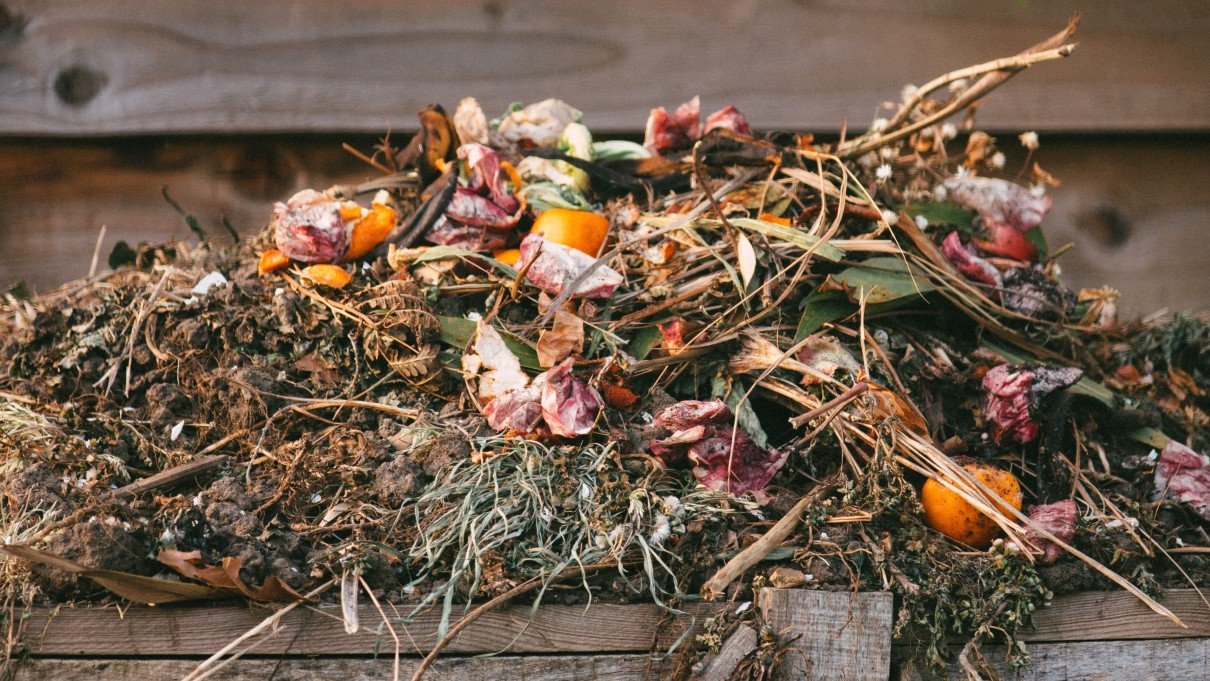What Gases Does Compost Release?

Whether you’ve started your own compost heap or are still considering it, you might be curious about the global warming impact of composting.
Composting is better for the environment than sending waste to landfills, but it still has its own environmental impact.
Does composting release greenhouse gases?
Composting is typically done by an aerobic process that relies on bacteria that need oxygen. Aerobic composting uses organic materials, oxygen, and water, and results in carbon dioxide, water, and energy in the form of heat.
Anaerobic composting, which takes longer and produces less heat, is mostly associated with compost bins and other sealed containers. It requires just organic materials and water but releases carbon dioxide, methane, hydrogen sulfide, and energy.
While all composting results in greenhouse gases, the amount varies depending on the maintenance of your compost.
Does compost generate CO2?
Carbon dioxide is present in both aerobic and anaerobic composting conditions. The more oxygen available to your compost, the more carbon dioxide will be released, but much of it will replace methane emissions (which are more present in anaerobic conditions).
The carbon dioxide produced by composting can’t be helped. Even the natural biodegradation of food waste in the wild will produce carbon dioxide.
While carbon dioxide is the most common greenhouse gas, making up 76% of human-caused greenhouse gas emissions, it’s also the least harmful. The natural process of composting food waste is just that – natural.
Some believe that the carbon dioxide emissions from composting are actually carbon-neutral, as it’s part of the environment’s life cycle. Excessive concentrations of carbon dioxide are the problem – mostly caused by burning fossil fuels for fuel, heat, and manufacturing.
Does compost release carbon monoxide?
Industrial composting can release carbon monoxide, typically at low levels below 30 parts per million (ppm). Carbon monoxide levels become dangerous over 101 ppm.
An article on the Chartered Institution of Wastes Management identifies the risk of carbon monoxide emissions in industrial composting centers, as well as hydrogen emissions linked to anaerobic decay within industrial composting processes.
Carbon monoxide can also be released from compost heaps in small amounts and is more present in composting facilities. Composting without adequate oxygen levels results in higher concentrations of carbon monoxide.
By properly aerating your compost pile, you can reduce levels of carbon monoxide and methane. Turning your compost regularly adds more air into the waste and helps manage decomposition.
In composting facilities, methane and carbon dioxide can be used as biogas to fuel the facility. By harvesting the gases before they reach the atmosphere, the gases can be recycled into renewable energy.
Do compost heaps produce methane?
Methane is produced more in anaerobic conditions than aerobic, but open-air compost piles can still emit methane. The aerobic process means that oxygen is present, so methane-producing microbes aren’t active in composting conditions. It’s why turning your compost is so important.
Without turning compost, the inside of the compost becomes anaerobic and methane is released.
It is possible for compost heaps to produce methane when not properly maintained by using aerobic methods. More carbon dioxide is released from a compost pile instead of methane by using more air in the composting process.
How nitrous oxide is formed in compost
Nitrous oxide is a greenhouse gas produced in both aerobic and anaerobic conditions by nitrification or denitrification.
Aerated compost piles produce less nitrous oxide and methane than anaerobic compost, and finding the right balance of carbon to nitrogen sources in your pile can also contribute to better levels of nitrous oxide.
Does composting contribute to global warming?
Composting contributes to global warming by producing carbon dioxide, but composting actually reduces the amount of greenhouse gases the waste would otherwise produce.
By composting organic waste, we can help break down waste instead of letting it fill up and mummify in landfills. Organic waste in a landfill will undergo anaerobic fermentation, which releases a lot of methane into the atmosphere.
Compared to carbon dioxide, methane has over 80 times the warming power during the first two decades of being present in the atmosphere. While carbon dioxide has a longer-lasting effect, methane’s short-term harm can exacerbate the effects of global warming in the short term.
Global Warming Potential (GWP) is a measure of how much energy the emissions of 1 ton of greenhouse gases absorb over 100 years compared to carbon dioxide. Carbon dioxide remains in the atmosphere for thousands of years, but other greenhouse gases are much more harmful to the climate.
Methane has a GWP of 28-36, lasting around a decade but absorbing much more energy. Meanwhile, nitrous oxide has a GWP of 265-298, lasting for more than 100 years in the atmosphere.
Hydrogen is an indirect greenhouse gas with a GWP of 5.8 and can also be produced in anaerobic composting. Carbon monoxide is another indirect greenhouse gas with a smaller GWP of 1-3.
Other greenhouse gases, like chlorofluorocarbons, hydrofluorocarbons, hydrochlorofluorocarbons, perfluorocarbons, and sulfur hexafluoride have GWPs of potentially thousands or tens of thousands. These aren’t released in composting.
Even though carbon dioxide, methane, and nitrous oxide are released during the composting process, they’re present in such small amounts. Composted food waste releases only 14% of the greenhouse gas emissions they would in landfills.
Landfills produce carbon dioxide and methane in equal measures, while aerobic composting emits mostly carbon dioxide.
